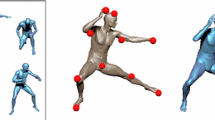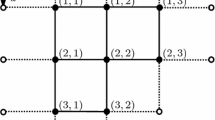Abstract
Using silhouettes in uncontrolled environments typically requires handling occlusions as well as changing or cluttered backgrounds, which limits the applicability of most silhouette based methods. For the purpose of 3-D shape modeling, we show that representing generic 3-D surfaces as implicit surfaces lets us effectively address these issues.
This desirable behavior is completely independent from the way the surface deformations are parame-trized. To show this, we demonstrate our technique in three very different cases: Modeling the deformations of a piece of paper represented by an ordinary triangulated mesh; reconstruction and tracking a person’s shoulders whose deformations are expressed in terms of Dirichlet Free Form Deformations; reconstructing the shape of a human face parametrized in terms of a Principal Component Analysis model.
Similar content being viewed by others
References
Agarwal, A. and Triggs, B. 2004. 3d human pose from silhouettes by relevance vector regression. In Conference on Computer Vision and Pattern Recognition.
Blanz, V. and Vetter, T. 1999. A morphable model for the synthesis of 3-D Faces. In Computer Graphics, SIGGRAPH Proceedings, Los Angeles, CA, pp. 187–194.
Boyer, E. and Berger, M.-O. 1997. 3D surface reconstruction using occluding contours. International Journal of Computer Vision, 22(3):219–233.
Canny, J. 1986. A computational approach to edge detection. IEEE Transactions on Pattern Analysis and Machine Intelligence, 8(6).
Carson, C., Belongie, S., Greenspan, H., and Malik, J. 2002. Blobworld: Image segmentation using expectation-maximization and its application to image querying. IEEE Transactions on Pattern Analysis and Machine Intelligence, 24(8):1026–1038.
Cipolla, R. and Blake, A. 1992. Surface shape from the deformation of apparent contours. International Journal of Computer Vision, 9(2):83–112.
Cross, G. and Zisserman, A. 2000. Surface reconstruction from multiple views using apparent contours and surface texture. In A. Leonardis, F. Solina, and R. Bajcsy (eds.), NATO Advanced Research Workshop on Confluence of Computer Vision and Computer Graphics, Ljubljana, Slovenia, pp. 25–47.
David, P., DeMenthon, D., Duraiswami, R., and Samet, H. 2002. SoftPOSIT: Simultaneous pose and correspondence determination. In European Conference on Computer Vision, Copenhagen, Denmark.
Davis, J.W. and Bobick, A.F. 1998. A robust human-silhouette extraction technique for interactive virtual environments. In Workshop on Modelling and Motion Capture Techniques for Virtual Environments, Geneva, Switzerland, pp. 12–25.
Dimitrijević, M., Ilić, S., and Fua, P. 2004. Accurate face models from uncalibrated and Ill-Lit video sequences. In Conference on Computer Vision and Pattern Recognition, Washington, DC.
Drummond, T. and Cipolla, R. 2002. Real-time visual tracking of complex structures. IEEE Transactions on Pattern Analysis and Machine Intelligence, 27(7):932–946.
Fua, P. 1999. Using model-driven bundle-adjustment to model heads from raw video sequences. In International Conference on Computer Vision, Corfu, Greece, pp. 46–53.
Fua, P. 2000. Regularized bundle-adjustment to model heads from image sequences without calibration data. International Journal of Computer Vision, 38(2):153–171.
Gavrila, D.M. and Davis, L.S. 1995. 3-d model-based tracking of human upper body movement: A multi-view approach. In IEEE International Symposium on Computer Vision, pp. 253–258. IEEE Computer Society Press.
Hartley, R. and Zisserman, A. 2000. Multiple View Geometry in Computer Vision. Cambridge University Press.
Ilić, S. and Fua, P. 2002. Using dirichlet free form deformation to fit deformable models to noisy 3-D data. In European Conference on Computer Vision, Copenhagen, Denmark.
Ilić, S. and Fua P. 2003. Generic deformable implicit mesh models for automated reconstruction. In ICCV Workshop on Higher-Level Knowledge in 3D Modeling and Motion Analysis, Nice, France.
Kass, M., Witkin, A., and Terzopoulos, D. 1988. Snakes: Active contour models. International Journal of Computer Vision, 1(4):321–331, 1988.
Kutulakos, K.N. and Seitz, S.M. 2000. A theory of shape by space carving. International Journal of Computer Vision, 38(3):197–216.
Moccozet, L. and Magnenat-Thalmann, N. 1997. Dirichlet free-form deformation and their application to hand simulation. In Computer Animation.
Paragios, N. and Deriche, R. 1998. A PDE-based level-set approach for detection and tracking of moving objects. In International Conference on Computer Vision, pp. 1139–1145.
Press, W.H., Flannery, B.P., Teukolsky, S.A., and Vetterling, W.T. 1992. Numerical Recipes, the Art of Scientific Computing. Cambridge, MA: Cambridge U. Press.
Rosten, E. and Tom Drummond. 2003. Rapid rendering of apparent contours of implicit surfaces for realtime tracking. In British Machine Vision Conference, vol. 2, pp. 719–728, Norwich, UK.
Rother, C. Kolmogorov, V. and Blake, A. 2004. “GrabCut”: Interactive foreground extraction using iterated graph cuts. ACM Transactions on Graphics, 23(3):309–314.
Sminchisescu, C. and Triggs, B. 2003. Kinematic jump processes for monocular 3D human tracking. In Conference on Computer Vision and Pattern Recognition, vol. I, pp. 69, Madison, WI.
Sullivan, S. and Ponce, J. 1998. Automatic model construction, pose estimation, and object recognition from photographs using triangular splines. In ICCV ’98: Proceedings of the Sixth International Conference on Computer Vision, Washington, DC, USA, pp. 510, IEEE Computer Society.
Sullivan, S. Sandford, L., and Ponce, J. 1994. Using geometric distance fits for 3-d. object modeling and recognition. IEEE Transactions on Pattern Analysis and Machine Intelligence, 16(12):1183–1196.
Szeliski, R. and Weiss, R. 1998. Robust shape recovery from occluding contours using a linear smoother. International Journal of Computer Vision, 28(1):27–44.
Terzopoulos, D. and Metaxas, D. 1991. Dynamic 3D models with local and global deformations: Deformable superquadrics. IEEE Transactions on Pattern Analysis and Machine Intelligence, 13:703–714.
Vacchetti, L., Lepetit, V., and Fua, P. 2004. Combining edge and texture information for real-time accurate 3D camera tracking. In International Symposium on Mixed and Augmented Reality, Arlington, VA.
Vaillant, R. and Faugeras, O.D. 1992. Using occluding contours for 3D object modeling. IEEE Transactions on Pattern Analysis and Machine Intelligence.
Author information
Authors and Affiliations
Corresponding author
Additional information
This work was supported in part by the Swiss National Science Foundation
Electronic supplementary material
Rights and permissions
About this article
Cite this article
Ilić, S., Salzmann, M. & Fua, P. Implicit Meshes for Effective Silhouette Handling. Int J Comput Vision 72, 159–178 (2007). https://doi.org/10.1007/s11263-006-8595-0
Received:
Revised:
Accepted:
Published:
Issue Date:
DOI: https://doi.org/10.1007/s11263-006-8595-0




